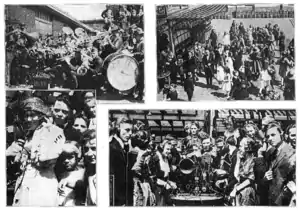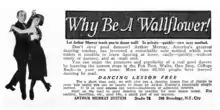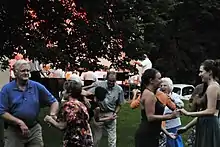Arthur Murray
Arthur Murray (born Moses Teichman, April 4, 1895 – March 3, 1991) was an American ballroom dancer and businessman, whose name is most often associated with the dance studio chain that bears his name.[2]
Arthur Murray | |
|---|---|
| Born | Moses Teichman April 4, 1895 |
| Died | March 3, 1991 (aged 95) |
| Alma mater | Georgia Institute of Technology |
| Occupation | Founder of franchise "Arthur Murray Dance Studios" |
| Years active | 1938–1991 |
| Spouse(s) | Kathryn Kohnfelder Murray, 1906–1999 (widowed)[1] |
| Children | Jane Murray (m. Dr. Henry Heimlich) Phyllis Murray (m. Edward Irvine "Ted" McDowell) |
His pupils included Eleanor Roosevelt, the Duke of Windsor, John D. Rockefeller Jr., Cornelius Vanderbilt Whitney, Barbara Hutton, Elizabeth Arden, Manuel L. Quezon, Johnny Mercer, and Jack Dempsey. Television evangelist D. James Kennedy and Little House on the Prairie actress Katherine MacGregor were instructors of Murray's technique.
Arthur Murray was inducted into the National Museum of Dance's Mr. & Mrs. Cornelius Vanderbilt Whitney Hall of Fame in 2007.
Early life and start in dance

Arthur Murray was born in 1895 as Moses Teichman in Galicia, Austria-Hungary, to a family of Jewish background.[3][4] In August 1897, he was brought to America by his mother Sarah on the S.S. Friesland, and landed at Ellis Island. They settled in Ludlow Street, in the Lower East Side of Manhattan with his father, Abraham Teichmann.
Murray was shy as a child and self-conscious about his tall, lanky appearance. He wanted very much to be a part of the social activities that most of his friends enjoyed, particularly the dances, but was afraid to socialize with girls. At the age of 14, Joe Feigenbaum, a friend of his whom he admired because of his popularity with girls, taught him his first dance steps. To get practice on the dance floor, Murray attended weddings in his neighborhood, where he found willing dance partners of every size and age.
In 1912, at the age of 17, he taught dance at night while working as a draftsman by day. He studied under the popular dance team of Irene and Vernon Castle and went to work for them.
Murray won his first dance contest at the Grand Central Palace, a public dance hall where he later became a part-time dance teacher after graduation from high school. The first prize had been a silver cup, but Murray went home with nothing to show for his win. His partner of the evening took it; it was destined for a pawnshop. This loss made an impression on Murray, and in later years every winner in his dance contests took home a prize.
Between jobs as a dance instructor, Murray worked as a draftsman at the Brooklyn Navy Yard and as a reporter at the New Haven Register.
He soon began teaching ballroom dancing to patients from the greater Boston, area, at the Devereux Mansion Physical Therapy Clinic in Marblehead, Massachusetts, before moving to Asheville, North Carolina. Murray arrived at the Battery Park Hotel November 28, 1914, at age 19 and began teaching dance there. At the outbreak of World War I, under the pressure of the anti-German sentiment prevalent in the U.S., Murray changed his last name of Teichman to a less German-sounding name. The Asheville Citizen reported in 1920 that Murray had spent six summers teaching at the Battery Park. At that time, he had also begun his chain of dance studios and become a well-paid dance writer. He had also signed a deal to produce records for teaching dance for Columbia Gramophone Company.[5]
In 1919, Murray began studying business administration at the Georgia School of Technology, and taught ballroom dancing in Atlanta at the Georgian Terrace Hotel. In 1920, he organized the world's first "radio dance"; a band on the Georgia Tech campus played "Ramblin' Wreck from Georgia Tech" and other songs, which were broadcast to a group of about 150 dancers (mostly Tech students) situated atop the roof of the Capital City Club in downtown Atlanta.[6]
Murray was inspired by a casual remark made by William Jennings Bryan one evening at the hotel: "... You know, I have a fine idea on how you can collect your money. Just teach 'em with the left foot and don't tell 'em what to do with the right foot until they pay up!" Murray thought about Bryan's remark, and devised the idea of teaching dance steps with footprint diagrams supplied by mail. Within a couple of years, over 500,000 dance courses had been sold.
On April 24, 1925, Murray married his famous dance partner, Kathryn Kohnfelder (September 15, 1906, Jersey City, New Jersey – August 6, 1999, Honolulu, Hawaii),[1] whom he had met at a radio station in New Jersey. She had been in the audience while he was broadcasting a dance lesson.
After their marriage, the mail-order business declined and the Murrays opened a dance school offering personal instruction. Their business prospered, especially in 1938 and 1939 when Arthur picked two little-known dances, the "Lambeth Walk" and "The Big Apple", and turned them into dance crazes. They were taught at hotel chains throughout the country, and the name "Arthur Murray" became a household word.
There are now hundreds of Arthur Murray studios globally, with specially trained instructors, making Arthur Murray the most successful dance instructor in history.
Arthur and Kathryn Murray had twin daughters, Jane and Phyllis. On June 4, 1951, Jane married Dr. Henry Heimlich who became famous for the Heimlich maneuver in 1974. Phyllis married educator Edward Irvine "Ted" McDowell.
The start of Arthur Murray Studios


His first business was selling dance lessons by mail, using a kinetoscope. Though the idea was successful, he had problems with the business, which failed. His second business was drawing and selling "footprints" which prospective dancers placed on the floor and followed to learn dancing. This mail-order business remained successful. His third business, launched in 1925, involved selling branded dance lessons through franchising. He trained dance instructors for the Statler Hotel chain, who then went to various hotels and gave lessons; Murray kept some of the profits from each franchise.
This business was expanded more widely in 1938, when an Arthur Murray dance studio franchise was opened in Minneapolis, Minnesota. Others followed. His slogan was: "If you can walk, we teach you how to dance", and the company guaranteed that the pupils learn to dance in ten lessons.
After WWII, Murray's business grew with the rise of interest in Latin dance, and he regularly taught and broadcast in Cuba in the 1950s. Murray went on television with a dance program hosted by his wife, Kathryn Murray, The Arthur Murray Party, which ran from 1950 to 1960, on CBS, NBC, DuMont, ABC, and then on CBS. Among the Arthur Murray dance instructors in the early 1950s was future television evangelist D. James Kennedy, who won first prize in a nationwide dance contest.[7] He appeared as a guest on the June 17, 1956, episode of What's My Line?.[8]
The Murrays retired in 1964; but they continued to be active for some time, appearing as guests on the Dance Fever disco show in the late 1970s. By then, there were more than 3,560 dance studios bearing his name. In 2007, about 220 Arthur Murray Studios remained in operation. Arthur Murray Dance Studios claims to be the second-oldest franchised company (the first, A&W Restaurants, began in 1919). In 2019, Arthur Murray Studios celebrated more than 100 years of teaching dance at over 270 Arthur Murray Dance Studios in 22 countries across the globe.[9] These range from studios in Australia (where the prestigious Crows Nest[10] and Parramatta[11] Dance Studios are located) all the way throughout America, Europe and Asia.
Death
For many years, Murray had two homes – one in Honolulu and another in Rye, New York. He died at his Honolulu home at the age of 95; according to his daughter, Phyllis Murray McDowell, pneumonia was the cause of death. He had been active and in good health until a short time before his death.[12]
In popular culture
- In the 1978 Broadway musical Ballroom, a line in the song "I Love To Dance" goes "You were meant to be cheek to cheek with me, Arthur Murray can't shine your shoes."
- The Murray name and franchise were featured in the hit song "Arthur Murray Taught Me Dancing in a Hurry" (1942) written by Johnny Mercer and Victor Schertzinger.
- The song "Cuban Pete" contains the line, "And Cuban Pete don't teach you in a hurry, like Arthur Murray."
- Hal Borne and His Orchestra recorded the Mercer-Schertzing song in a Soundie released May 25, 1942, with the Three Murtah Sisters.[13]
- In the Mark Robson directed film, Phffft! (1954), starring Jack Lemmon, Judy Holliday, and Kim Novak, Lemmon's character (Robert Tracey) is seen walking into an Arthur Murray Dance Studio in New York to work on his Rumba with teacher Merry Anders.
- On 29 December 1957, Buddy Holly and The Crickets performed during a live broadcast of the Arthur Murray Dance Party, consisting of "That'll Be the Day" and "Peggy Sue". Along with their two appearances on The Ed Sullivan Show, this is the only known live footage of Buddy Holly in his short lifetime.
- Arthur Murray is portrayed in an episode of the HBO television drama Boardwalk Empire.
- The Arthur Murray "footprints" are satirized in several animated cartoons from the 1940s. They are also painted on the kitchen floor in the film 1941, in which one of the kitchen workers is a dance contestant who practices while working.
- In the Dirty Dancing (1987) scene where Johnny Castle teaches Baby dance while balancing atop a log, he tells her he got his start in dancing when Arthur Murray was looking for new dance instructors.
- In a season one episode ("The Alluring Au Pair") of The Mysteries of Laura, the Medical Examiner is said to have been going to teach an Arthur Murray class when he is called to examine the body.
- In the Billy Wilder movie The Apartment that won the 1960 Academy Award for best picture, the lead character C.C. "Bud" Baxter boasts of being an Arthur Murray graduate.
- Vic Chesnutt's "Arthur Murray" contains the lines "Who gets to lead/Do know it's not Arthur Murray."
- In the 1957 Rodgers and Hart musical Pal Joey, Joey Evans (Frank Sinatra) while watching a number being performed by Mrs. Prentiss Simpson aka Vanessa, the Undresser (Rita Hayworth) remarks to friend Ned Galvin (Bobby Sherwood) that "She didn't pick up that action at Arthur Murray's".
- A depiction of Arthur Murray appeared in an episode of The Flintstones (Season 6, episode 12 - "Shinrock A Go-Go"). He is shown asking for dancing lessons from Fred Flintstone after Fred invents a new dance, called the Frantic.
- A reference is made by fictional characters in the British television series Only Fools and Horses (Season 3, Episode 1 - "Homesick.") Rodney Trotter tells Margaret Mackenzie (a member of the Tenant's Association) that his brother, Derek Edward Trotter (Del Boy), "...was at the Arthur Murray School, Lewisham." Rodney's comment is made shortly after the member of the Tenant's Association declares that she was a student of dance "...at the London School of Dance, Knightsbridge."
- British folk singer/writer Richard Thompson's song "Tear Stained Letter", referenced Arthur Murray. The first verse contains the line "She danced on my head like Arthur Murray..." The song appears on the 1983 album Hand of Kindness.
- In the folk song "Would You Like to Learn to Dance" by Steve Goodman the first verse includes the reference 'we can draw the Arthur Murray pattern right here on the floor'.
References
- Jackson, Kenneth T.; Markoe, Karen (December 1, 2001). The Scribner Encyclopedia of American Lives: 1997-1999. Gale / Cengage Learning. p. 411. ISBN 9780684806631.
- Obituary Variety, March 11, 1991.
- McFaddden, Robert D. (December 17, 2016). "Dr. Henry J. Heimlich, Famous for Antichoking Technique, Dies at 96". New York Times. Retrieved December 17, 2016.
- https://familysearch.org/ark:/61903/1:1:X4GD-G8V
- Neufeld, Rob (2017-07-31). "Visiting Our Past: Arthur Murray among Battery Park's denizens". Asheville Citizen-Times. Retrieved 2017-07-31.
- "Arthur Murray Taught the World to Dance". Tech Topics. Georgia Tech Alumni Association. Summer 1991. Archived from the original on 2007-10-12. Retrieved 2007-06-11.
- Chandler, E. Russell (1972). The Kennedy Explosion. Elgin, IL: David C. Cook Publishing. ISBN 0-912692-02-2.
- "What's My Line? - Arthur Murray; Pier Angeli & Vic Damone; Paul Winchell [panel] (Jun 17, 1956)". Youtube.com.
- "The History of Arthur Murray Dance Studios: Celebrating 100 years of ballroom dancing Arthur Murray International". arthurmurray.com. Retrieved 2019-03-18.
- "Dance Classes | Arthur Murray Crows Nest". Dance Classes | Arthur Murray Crows Nest. Retrieved 2019-09-25.
- "Dance Lessons Parramatta - Arthur Murray Dancing Studio". www.ballroomdanceparramatta.com.au. Retrieved 2019-03-18.
- Pace, Eric (March 4, 1991). "Arthur Murray, Dance Teacher, Dies at 95". Nytimes.com.
- The Soundies Distributing Corporation of America: a history and filmography of their "jukebox" musical films of the 1940s. Terenzio, MacGillivary, Okuda. 1954. page 79. ISBN 0-89950-578-3
External links
 Media related to Arthur Murray at Wikimedia Commons
Media related to Arthur Murray at Wikimedia Commons- Arthur Murray Dance Studios
- "Arthur Murray". Find a Grave. Retrieved August 10, 2010.